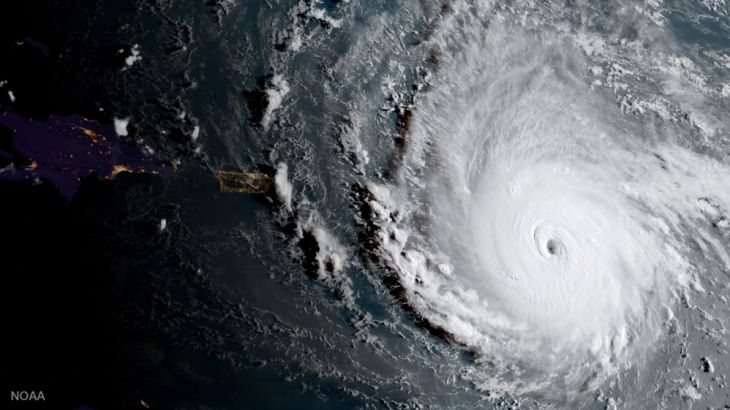Officials warn of ‘powerful’ Hurricane Irma impact
Irma headed towards Puerto Rico, Haiti, Cuba and Florida, with potential for coastal storm surges of up to six metres.

A powerful Atlantic Ocean hurricane has made its first landfall in the islands of the northeast Caribbean, en route to Puerto Rico, the Dominican Republic, Haiti and Cuba before possibly heading for the US state of Florida.
Hurricane Irma carries the potential for coastal storm surges of up to six metres above normal tide levels, the Miami-based National Hurricane Centre said on Wednesday.
Keep reading
list of 4 itemsScientists say Oman, UAE deluge ‘most likely’ linked to climate change
Photos: Deadly floods wreak havoc in Kenya’s capital
China evacuates over 100,000 as heavy rain continues to lash south
The National Weather Service said Puerto Rico had not seen a hurricane of Irma’s magnitude since Hurricane San Felipe in 1928, which killed a total of 2,748 people in Guadeloupe, Puerto Rico and Florida.
Warm water is fuel for hurricanes and Irma is over water that is 1C warmer than normal.
The 26C water that hurricanes need goes about 80 metres deep, said Jeff Masters, meteorology director of the private forecasting service Weather Underground.
READ MORE: Harvey exposes Houston’s vulnerability
The eye of Irma passed over Barbuda at about 1:47am local time (05:47 GMT), the National Weather Service said.
Residents said over local radio that phone lines went down. Heavy rain and winds buffeted the neighbouring island of Antigua, sending debris flying as people huddled in their homes or government shelters.
Officials warned people to seek protection from Irma’s “onslaught” in a statement that closed with: “May God protect us all.”
“This is not an opportunity to go outside and try to have fun with a hurricane,” US Virgin Islands Governor Kenneth Mapp said. “It’s not time to get on a surfboard.”
The Category 5 storm had maximum sustained winds of 295km per hour (kph), said the National Hurricane Centre.
Its forecast late on Tuesday was for the winds to fluctuate slightly but for the storm to remain at Category 4 or 5 strength for the next day or two.
Dangerous winds
The most dangerous winds, usually nearest to the eye, were forecast to pass near the northern Virgin Islands and near or just north of Puerto Rico through Wednesday.
On Antigua island, people who live in low-lying areas were staying with friends and relatives on higher ground or sleeping in churches, schools and community facilities built to withstand hurricanes.
None of the shelters has yet been tested by Category 5 winds, however.
These are times for the most likely arrival of winds too strong to continue hurricane #Irma prep actions. Prep now!https://t.co/EtEGhob4E6 pic.twitter.com/TgM8s76VjI
— National Weather Service (@NWS) September 6, 2017
Many homes in Antigua and Barbuda are not built on concrete foundations or have poorly constructed wooden roofs that are susceptible to wind damage.
Other islands in the path of Irma included the Virgin Islands and Anguilla, a small, low-lying territory of about 15,000 people.
President Donald Trump declared emergencies in Florida, Puerto Rico and the US Virgin Islands, and authorities in the Bahamas said they would evacuate six southern islands.
“The dangerousness of this event is like nothing we’ve ever seen,” Ricardo Rossello, Puerto Rico governor, said.
“A lot of infrastructure won’t be able to withstand this kind of force.”
The director of the island’s power company has warned that storm damage could leave some areas without electricity for about a week and other, unspecified areas for four to six months.
|
|